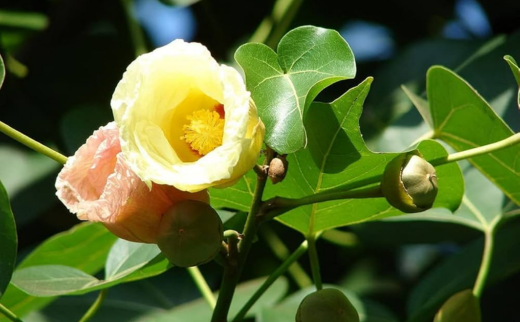Thespesia populnea Soland. Ex Correa./ Paras Pipal/ Portia Tree/ Indian Tulip Tree
Abstract
Thespesia populnea Linn., commonly known as Paras-pipal and belonging to the family Malvaceae, is a significant plant in traditional herbal medicine. It is widely cultivated in tropical regions for ornamental and shade purposes. Different parts of the plant exhibit a range of therapeutic properties, including antibacterial, anti-inflammatory, antioxidant, purgative, hepatoprotective, and antimalarial effects. The fruit is traditionally used as an antidote for poisoning, while the seeds are recognised for their purgative action. Phytochemical investigations reveal that Thespesia populnea is rich in various bioactive constituents such as flavonoids, sesquiterpenoids, tannins, saponins, alkanes, essential oils, sugars, fatty acids and antioxidants, which contribute to its diverse medicinal applications.

Introduction
Thespesia populnea (L.) Soland. Ex Correa, also known as the ‘Portia tree’ or ‘Indian tulip tree’, holds a significant place in traditional medicine, especially within the Ayurvedic system. It is valued for its diverse healing properties, including astringent, cooling, depurative, haemostatic, anti-inflammatory, and antidiarrhoeal actions. Different parts of the plant, such as the root, bark, leaves, flowers, and fruits, are traditionally used to treat various health conditions. These include disorders related to the skin, liver, digestive system, and inflammatory states. Contemporary scientific studies have validated many of these traditional claims, emphasising the therapeutic promise of Thespesia populnea and its relevance in the development of plant-based medicines.
Scientific Classification
- Kingdom: Plantae
- Division: Magnoliophyta
- Class: Magnoliopsida
- Order: Malvales
- Family: Malvaceae
- Genus: Thespesia
- Species: Thespesia populnea Linn.
Synonyms
- Gardabhanda: Named due to its fruits resembling the shape of a donkey’s testicles.
- Pareesha: Another traditional name for the plant.
- Kapitana: Refers to the fruit’s colour, which is said to resemble the skin tone of a monkey.
- Kamandalu: An alternative name used in traditional texts.
- Kandarala: Indicates that the roots of the plant penetrate deep into the soil.
- Suparshvaka
- Kapichuta
- Palash
Vernacular Names
- Hindi: Paras-pipal, Parasapeepala
- English: Portia tree, Umbrella tree, Indian Tulip tree, Pacific Rosewood, Seaside Mahoe
- Marathi: Bhendikejhar
- Kannada: Jogiyarale, Arasi, Bugari mara
- Gujarati: Paarsapeepala
- Sanskrit: Gardha-bhanda, Parisha
- Tamil: Cheelnathi, Puravasu
- Telugu: Gangaraavi, Ganga ravi chettu
- Malayalam: Poovarasu
- Bengali: Pakur
- Sinhalese: Suriya
- Malay: Bebaru, Baru baru
Habitat
Thespesia populnea, commonly known as the Indian Tulip Tree or Portia Tree, is a medium-sized evergreen tree predominantly found in coastal areas across India and other tropical regions.
Morphology
Thespesia populnea, a member of the Malvaceae family, is an evergreen tree that can reach a height of up to 20 meters. It features dark brown bark and broad, glossy green leaves. The tree produces bright yellow flowers with five distinct petals. Its fruit is a hard, woody capsule containing numerous small seeds. Well-adapted to coastal environments, the tree is highly resistant to salt spray and strong coastal winds.
Classical Categorisation
- It is classified under Panchavalkala (According to Acharya Bhavmishra), a group of five medicinal plants known for their astringent bark properties.
- As per Charaka Samhita, it is listed under the Mutra Sangrahaneeya category, indicating its effectiveness in managing urinary tract disorders and supporting urinary retention.
- In Bhavprakash Nighantu, it is classified under Vatadi varga.
Ancient Verses
पारीषो दुर्जरः स्निग्धः कृमिशुक्रकफप्रदः ।
फलेऽम्लो मधुरो मूले कषायस्वादुमज्जकः ॥
(Bhavprakash Nighantu Vatadi varga 5)
According to the above shloka, Pareesha is heavy to digest, unctuous and increases Kapha dosha. It is aphrodisiac in nature and increases worm growth. Its fruit has a sour taste, the root has a sweet taste, and the pulp has an astringent taste.
Ayurvedic Properties
- Taste (Rasa): Fruit (Sour), Root (Sweet), Pulp (Astringent)
- Physical property (Guna): Heavy (Guru), Unctuous (Snigdha)
- Effect on Tridosha: Increases Kapha dosha
Systemic Actions
External Uses
Aids in reducing inflammation and promotes faster healing of fractures; beneficial in skin disorders, especially those with itching.
Internal Uses
- Digestive system: Acts as an absorbent and is useful in managing diarrhoea and haemorrhoids.
- Circulatory system: Helpful in treating bleeding disorders.
- Excretory system: Reduces excessive urine output and is beneficial in the management of diabetes.
- Reproductive system: Effective in treating leucorrhea and other female reproductive disorders.
- Tvak (Skin): Useful in various skin diseases.
- Tapakrama (Burning sensation): Helps alleviate burning sensations in the body.
Chemical Composition
Alkaloids
- 2-(4-hydroxyhept-5-enyl)-3-methylhexahydropyrrolo[2,1-b][1,3]oxazin-4-one
- Gossypol
Glycosides
- Populin
- Popuneol
- Populnatin
Terpenes
Pentacyclic Triterpenoids
- Lupenol
- Lupenone
- Betulin
Sesquiterpenoids
- Populene A
- Populene B
- Populene C
- Populene D
- Populene E
- Populene F
- Populene G
- Populene H
Sesquiterpenoid Quinones
- Mansonone C
- Mansonone D
- Mansonone E
- Mansonone F
- Mansonone G
- Mansonone H
- Mansonone S
Sesquiterpene Quinones
- Thespesenone
- Dehydro-oxoperezinone
- Dehydro-oxoperezinone 6-methyl ether
Phenolic Compounds (Flavonoids)
- Kaempferol
- Kaempferol 5-glucosides
- Kaempferol 7-glucosides
- Gossypetin
- Herbacetin
- Rutin
- Kaempferol 3-rutinosides
Steroids
- β-sitosterol
- Daucosterol
- β-sitosterol-β-D-glucoside
Fatty Acids and Alcohols
- Stearic acid
- Myricyl alcohol
- 1-Hentriacontanol
Alkanes
- Nanacosane
- Thespone
- Thespesone
- Amino acids
Modern Overview
Wound Healing and Bacterial Infections
Thespesia populnea exerts its therapeutic effects through a synergistic action of various bioactive compounds. Its antioxidant activity, primarily due to flavonoids, tannins, and saponins, helps neutralise free radicals, thereby protecting cells from oxidative damage. The plant also demonstrates strong anti-inflammatory effects, as compounds like lupeol, β-sitosterol and quercetin suppress inflammatory mediators, reducing pain and swelling. Its wound-healing properties are attributed to terpenoids and sesquiterpenoidal quinones such as thespesone and mansonones, which enhance tissue regeneration and collagen production. The astringent and hemostatic nature of its tannins makes it effective in controlling bleeding, diarrhoea, and managing skin conditions. Lastly, the plant exhibits antimicrobial activity, where compounds like quercetin and herbacetin help combat bacterial and fungal infections, making Thespesia populnea a comprehensive remedy in traditional and modern herbal medicine.
Anti-psoriatic Activity
Thespesia populnea has long been recognised for its anti-psoriatic properties, and recent studies have further validated this traditional use. Phytochemical analysis of various parts of the plant, including the leaves and bark, confirmed the presence of active constituents such as triterpenoids, tannins, glycosides, phytosterols, and flavonoids, which contribute to its therapeutic effects. From the bark extract, three specific compounds were isolated: TpS-2, TpF-1, and TpF-2. Using Perry’s scientific mouse tail model, the anti-psoriatic potential of different extracts and isolated compounds was evaluated through topical application. Among them, TpF-2 and the petroleum ether extract showed the most significant and promising results.
Anticancer Effect
Thespesia populnea has demonstrated notable anticancer and cytotoxic properties in several studies. Researchers have isolated and identified eleven previously known compounds and eight novel sesquiterpenoids, named Populene A–H, from this plant. Among them, Mansonone E and (+)-Gossypol exhibited strong cytotoxic effects against four different cancer cell lines. Additionally, the ethanolic extract of Thespesia populnea bark showed significant chemopreventive activity against 7,12-dimethylbenz[a]anthracene (DMBA)-induced carcinogenesis in the hamster buccal pouch model, effectively reducing the number, type, and size of tumours.
Practical Uses
- The paste of its bark or root is applied externally for the treatment of tinea (fungal) infections.
- The fruit ash mixed with coconut oil and applied to the place of itching.
Part Used
Stem bark
Dosage
Powder – 2–6 gm
Conclusion
Thespesia populnea is a versatile medicinal plant widely recognised in traditional systems of medicine, particularly Ayurveda and Siddha. It exhibits a broad spectrum of therapeutic properties, including anti-inflammatory, antioxidant, antimicrobial, hepatoprotective, and anti-psoriatic effects. Various parts of the plant, such as the bark, leaves, flowers, and roots, are used for treating skin diseases, liver disorders, wounds, ulcers, and respiratory ailments. The presence of active constituents like flavonoids, tannins, terpenoids, and glycosides supports its medicinal efficacy. Due to its multifaceted pharmacological activities and cultural significance, Thespesia populnea holds great potential for further research and development in herbal medicine and pharmacognosy.



